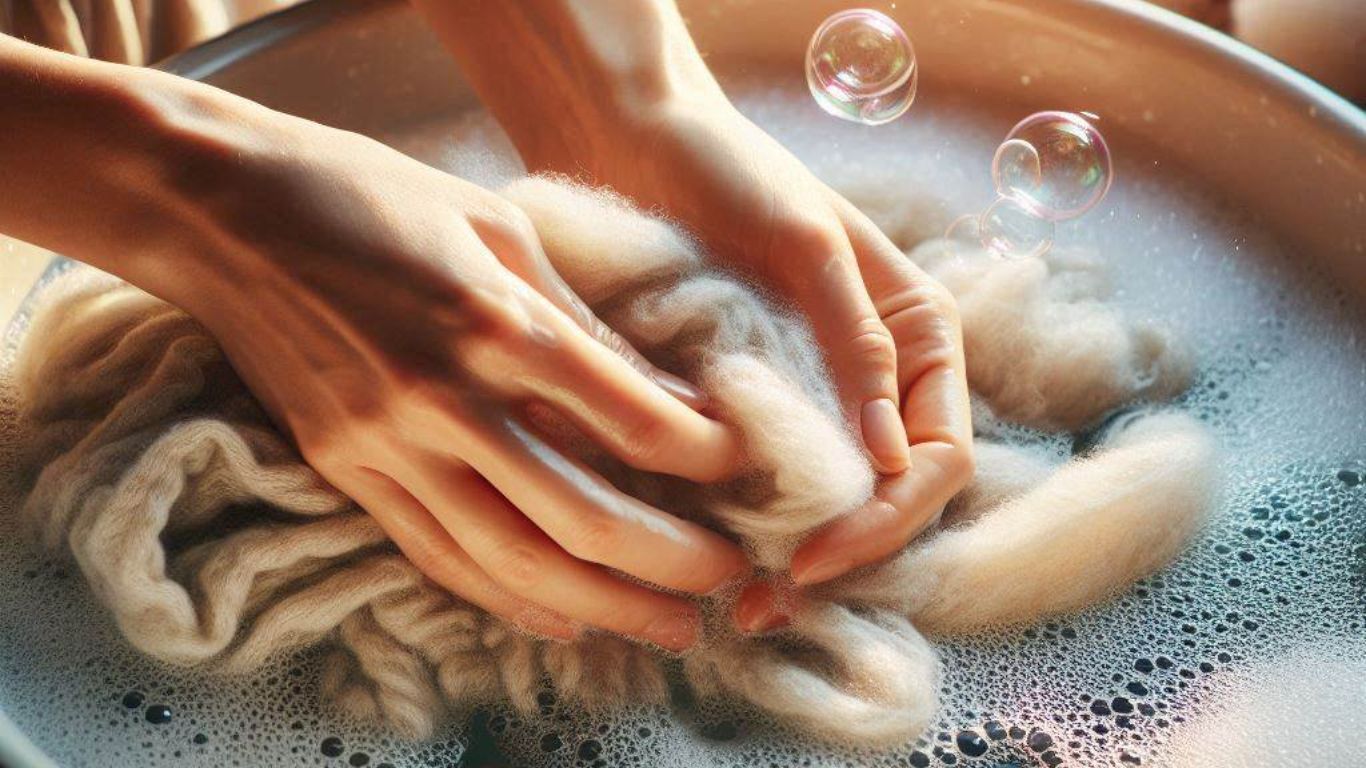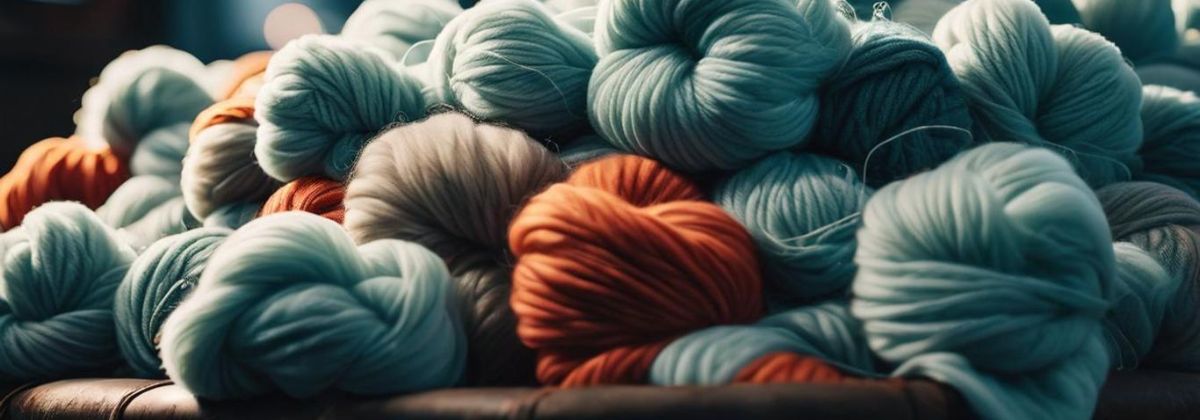22 Jul Mastering Wool Care: The Complete Guide to Washing and Maintaining Wool Fabrics
Wool fabric is a luxurious and versatile material that requires special care to maintain quality and longevity. Properly washing wool fabric is crucial to preserve its softness, durability, and appearance. Many people hesitate to wash wool garments at home due to fear of damaging them. However, washing wool fabric can be straightforward with the proper techniques and knowledge.Tips for Washing Wool Fabric
What Do You Need to Know about Wool?
Wool fabric is a natural textile made from the fleece of sheep and other animals, such as goats (producing cashmere and mohair), alpacas, and llamas. Renowned for its luxurious feel and exceptional insulating properties, wool has been a staple in clothing and textiles for centuries.
Wool’s unique structure consists of overlapping scales that create a crimped texture, allowing it to trap air and provide excellent insulation. This structure keeps you warm in cold weather and wicks moisture away from the skin, keeping you dry and comfortable. Wool is naturally elastic, which helps garments maintain their shape and resist wrinkles. Its natural lanolin content makes it water-resistant and helps repel dirt and stains.
Characteristics of Wool
- Insulating Properties: Wool’s natural crimp and structure allow it to trap air, providing excellent insulation. This makes wool garments warm in cold weather while still breathable enough to wear in milder conditions.
- Moisture Wicking: Wool can absorb moisture up to 30% of its weight without feeling damp. This property helps keep you dry by wicking sweat away from the skin, making it comfortable to wear in various climates.
- Breathability: The fibre structure of wool allows for better airflow compared to synthetic fabrics, enhancing breathability and helping regulate body temperature.
- Elasticity: Wool fibres are naturally elastic, allowing them to stretch and return to their original shape. This elasticity helps wool garments resist wrinkles and maintain their form over time.
- Odour Resistance: Wool has natural antimicrobial properties that help it resist odours. This means wool clothing can be worn multiple times between washes without developing unpleasant smells.
- Durability: Wool is a strong and durable fabric, capable of withstanding wear and tear. When cared for properly, wool garments can last for many years.
- Water Resistance: The natural lanolin in the wool makes it water-resistant. While not completely waterproof, wool can repel light rain and spills, providing some protection against the elements.
- Fire Resistance: Wool is naturally fire-resistant due to its high nitrogen and water content. It does not ignite easily and can self-extinguish, making it a safer choice for clothing and home textiles.
- Biodegradability: Wool is a natural, renewable resource that is biodegradable. Unlike synthetic fibres, wool will break down over time, making it an environmentally friendly option.
- Softness: High-quality wool, such as Merino and cashmere, is incredibly soft and gentle against the skin, providing a luxurious feel that is perfect for garments worn close to the body.
Preparation for Washing Wool Fabric
Reading Care Labels:
Before you begin, always read the care labels on your wool garments. These labels provide crucial information about each item’s appropriate washing temperature, detergent type, and drying method. Following these instructions helps maintain the fabric’s quality and prevents accidental damage.
Gathering Necessary Supplies:
To wash wool effectively, you’ll need a few supplies:
- Mild Wool Detergent: Use a specifically designed for wool to preserve its natural oils and softness.
- Basin or Sink: For hand washing, ensure it’s clean and free of any residues from previous uses.
- Clean Towel: A large, absorbent towel gently removes excess water after washing.
- Drying Rack: This is essential for air drying your wool garments without stretching them out of shape.
Sorting Wool Garments:
Separate your wool garments from other types of clothing. This prevents damage from zips, buttons, or rough fabrics. Also, sort them by colour to avoid any potential colour transfer during washing.
Hand Washing Wool Fabric
- Fill a Basin or Sink with Lukewarm Water: Use lukewarm water, as hot water can cause wool to shrink and lose its shape.
- Add a Small Amount of Wool Detergent: Use a detergent specifically designed for wool. Add it to the water and mix gently to create a soapy solution.
- Submerge the Wool Garment: Place the wool garment into the water. Gently swish it around without rubbing or wringing to avoid stretching or felting the fibres.
- Let it Soak: Allow the garment to soak for about 10-15 minutes. This helps the detergent to break down any dirt or oils.
- Rinse Thoroughly: Drain the soapy water and refill the basin with clean, lukewarm water. Swish the garment around to rinse out the detergent. Repeat this process until the water runs clear and no detergent remains in the fabric.
- Remove Excess Water: Gently press the garment against the side of the basin to remove excess water. Avoid wringing or twisting, as this can distort the shape of the wool.
- Use a Gentle Touch: Handle the wool garment carefully to avoid agitating the fibres. Rough handling can lead to pilling and damage.
- Avoid Hot Water: Always use lukewarm or cold water, as hot water can cause wool to shrink.
- No Rubbing or Wringing: Gently squeeze the garment to remove water, but never rub or wring it, as this can cause stretching and damage.
 Machine Washing Wool Fabric
Machine Washing Wool Fabric
- Place Garment in a Mesh Laundry Bag: Place the wool garment inside a mesh laundry bag to protect it. This prevents it from rubbing against other items and reduces the risk of damage.
- Add Wool-Safe Detergent: Measure and add the appropriate amount of wool-safe detergent to the washing machine.
- Select the Appropriate Cycle: Choose the delicate or wool cycle and ensure the correct temperature and spin settings.
- Start the Machine: Begin the washing cycle. Monitor the cycle to ensure everything runs smoothly.
- Promptly Remove Garment: Once the cycle is complete, remove the wool garment promptly to avoid creasing.
- Wash Similar Colours Together: Avoid washing wool garments with items that have zips, hooks, or rough textures that could damage the fabric.
- Avoid Overloading the Machine: Give your wool garments enough space to move freely in the washing machine to avoid excessive friction.
Drying Wool Fabric
Drying wool fabric properly is crucial to maintaining its shape, softness, and overall quality. Here’s how to dry your wool garments effectively:
- Lay Flat on a Clean Towel: Press the wool garment to remove excess water after washing. Lay it flat on a clean, dry towel.
- Roll the Towel: Roll the towel with the garment inside, pressing lightly to absorb more water. Avoid wringing or twisting the fabric.
- Lay Flat on a Drying Rack: Transfer the garment to a drying rack, laying it flat in its natural shape. Ensure the rack is in a well-ventilated area away from direct sunlight and heat sources.
- No Tumble Drying: Never use a tumble dryer for wool garments, as the heat can cause shrinkage and damage the fibres.
- Avoid Radiators and Heaters: Do not place wool items near radiators, heaters, or direct heat sources. Heat can cause shrinkage and loss of shape.
- Good Air Circulation: Drying racks provide excellent air circulation, helping the wool dry evenly without stretching.
- Maintain Shape: Ensure the garment is laid out naturally on the rack. Smooth out any wrinkles or folds.
- Patience is Key: Wool can take longer to dry than other fabrics, so be patient and allow ample time to dry completely.
- Turn Occasionally: If necessary, turn the garment over occasionally to ensure even drying.
Removing Stains from Wool
Stains on wool garments can be tricky to remove, but with the proper techniques, you can tackle them effectively without damaging the fabric. Here’s how to handle common stains on wool:
Identifying Common Wool Stains
- Food and Drink Stains: Coffee, wine, and food spills are common stains that can discolour wool.
- Grease and Oil Stains: These can come from cooking oils, lotions, or makeup.
- Dirt and Mud Stains: Often from outdoor activities or accidental spills.
Stain Removal Techniques
- Blot, Don’t Rub: When dealing with a fresh stain, gently blot the area with a clean, dry cloth or paper towel to absorb as much of the spill as possible. Avoid rubbing, as this can push the stain deeper into the fibres.
- Cold Water Rinse: For most stains, a quick rinse with cold water can help. Hold the stained area under cold running water, allowing the water to flow through the fabric and carry away some of the stain particles.
- Use a Mild Wool Detergent: Apply a small amount of wool detergent directly to the stain. Gently work it into the fabric with your fingers or a soft cloth. Let it sit for a few minutes before rinsing with cold water.
- Spot Cleaning Solution: Mix equal parts white vinegar and water. Dampen a clean cloth with the solution and gently blot the stain. This is effective for many types of stains and helps neutralise odours.
Homemade Stain Removal Solutions
- Cornstarch for Grease Stains: Sprinkle cornstarch or talcum powder on grease stains and let it sit for about 30 minutes to absorb the grease. Then, gently brush off the powder.
- Vinegar and Baking Soda Paste: Mix vinegar and baking soda for tougher stains. Apply it for 15 minutes, then rinse with cold water.
Additional Tips for Removing Stains
- Test First: Always test any stain removal solution on an inconspicuous area of the garment to ensure it doesn’t cause discolouration or damage.
- Act Quickly: Don’t let stains sit for long periods.
- Professional Help: Consider taking the garment to a professional cleaner for particularly stubborn stains or delicate wool items.
The Last Word
Caring for wool fabric requires attention and care, but the results are worth the effort. By understanding the unique characteristics of wool and following the proper techniques for washing, drying, and stain removal, you can ensure that your wool garments remain in excellent condition for many years. Whether hand washing or using a machine, always opt for gentle methods and wool-specific detergents to protect the fibres. Proper drying and stain removal techniques further enhance the longevity and appearance of your wool items. With these practices, you can enjoy wool’s warmth, comfort, and durability without worry, maintaining its natural beauty and functionality.




Sorry, the comment form is closed at this time.